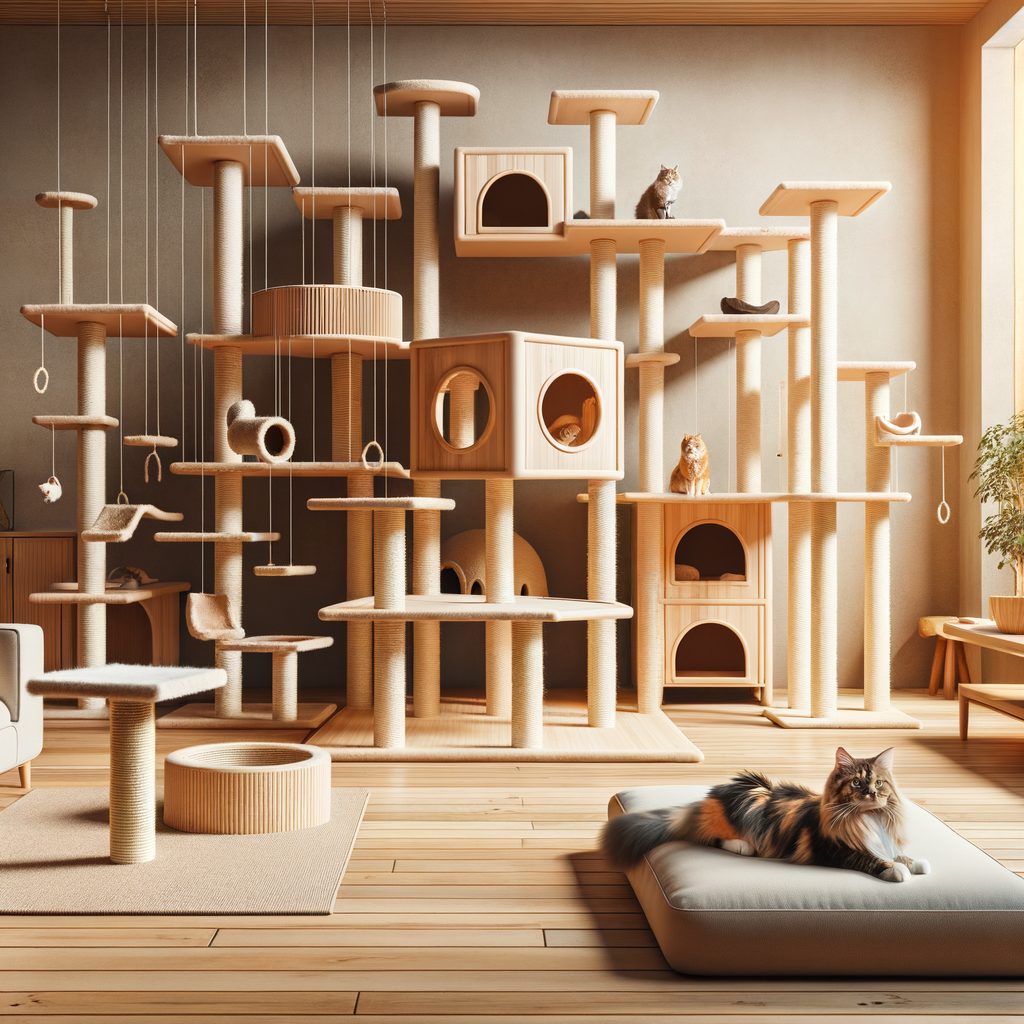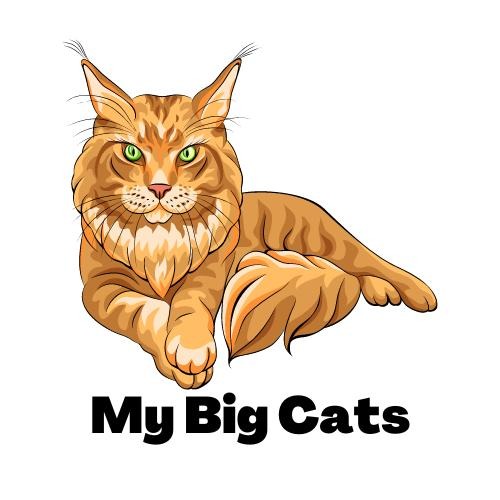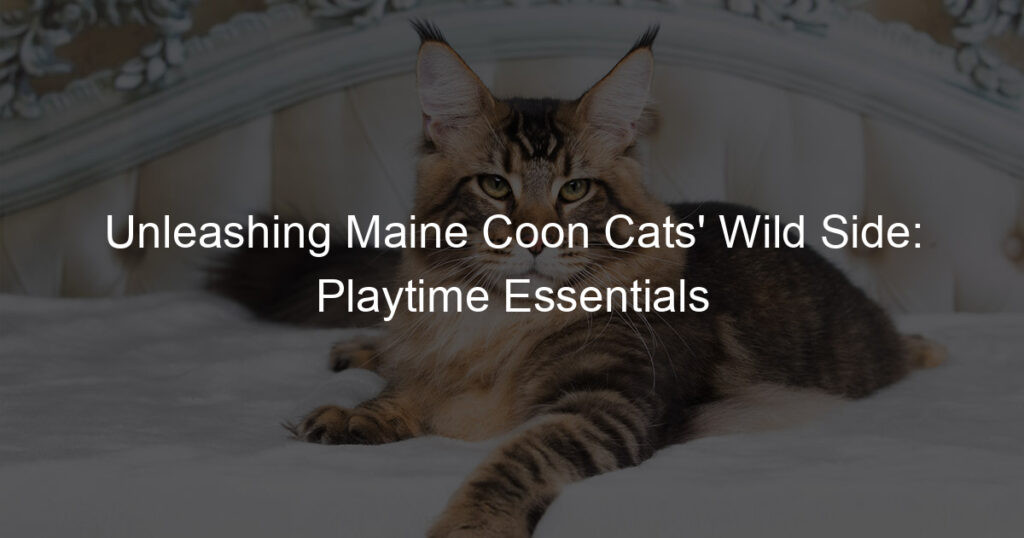
Introduction to Maine Coon Cats
Welcome to the fascinating world of Maine Coon Cats! These magnificent creatures are not only visually stunning but also possess a unique character that sets them apart from other cat breeds. In this section, we will provide an overview of Maine Coon Cats and delve into their unique characteristics.
- Overview of Maine Coon Cats
- Unique Characteristics of Maine Coon Cats
Known as the “gentle giants” of the cat world, Maine Coon Cats are one of the largest domesticated cat breeds. Originating from the United States, specifically the state of Maine, these cats are famous for their size, hunting skills, and notably friendly nature. They have a robust physique, with males typically weighing between 13 to 18 pounds and females between 8 to 12 pounds. However, their size doesn’t stop them from being agile and playful!
Maine Coon Cats are easily recognizable due to their distinctive physical features. They have large, tufted ears, high cheekbones, and a square muzzle. Their fur is long, dense, and water-resistant, which helped them survive in harsh winter climates. Their bushy tail, often as long as their body, serves as a warm wrap during cold weather.
But the uniqueness of Maine Coon Cats goes beyond their physical traits. They are known for their dog-like behavior, often following their owners around the house and showing a keen interest in water. They are also known for their trilling sound, a combination of a purr and a meow, which is unique to this breed.
In the following sections, we will explore how to create a suitable environment for your Maine Coon Cat, design a cat-friendly home, provide proper care, and share some inspiring case studies. So, stay tuned to learn more about these wonderful creatures and how to make them feel at home!
Understanding the Maine Coon Environment
As a Maine Coon cat owner or enthusiast, it’s crucial to understand the natural environment of these majestic felines. This knowledge will help you provide the best care for your Maine Coon, ensuring they live a healthy and happy life.
Maine Coon’s Natural Habitat
Maine Coons are known for their adaptability and resilience, traits that can be traced back to their origins and natural habitat. To fully appreciate these cats, let’s explore their roots and how they’ve adapted to their environment.
- Origins of the Maine Coon Cat
- Adaptations to their Natural Environment
The Maine Coon cat, as the name suggests, originates from the state of Maine in the United States. They are believed to be descendants of domestic short-haired cats and long-haired cats brought to America by European settlers. These cats had to endure harsh winters and a varied climate, which shaped their physical characteristics and behavior.
Maine Coons have developed several adaptations to survive in their natural environment. Their thick, water-resistant fur provides insulation during cold winters and sheds to keep them cool in summer. Their large, tufted paws act like snowshoes, allowing them to walk on snow without sinking. They also have a long, bushy tail they can wrap around their body for warmth. These adaptations make the Maine Coon a hardy breed, capable of surviving in various climates.
Understanding the Maine Coon’s natural habitat and how they’ve adapted to it can give us valuable insights into their needs and behaviors. This knowledge can help us create a more suitable and comfortable home environment for these beautiful cats.
Creating a Maine Coon Cat Home Environment
Designing a home environment for your Maine Coon cat can be a rewarding experience. It’s essential to consider the unique needs of this breed to ensure they are comfortable and happy. This involves simulating their natural habitat and incorporating key elements into your home.
- Importance of Simulating the Natural Habitat
- Key Elements of a Maine Coon Cat Home
Maine Coon cats are known for their love of climbing and exploring. In the wild, they would spend a lot of time in trees, hunting and surveying their territory. Simulating this environment in your home can help your cat feel more at ease. This can be achieved by providing climbing trees or shelves, and toys that stimulate their hunting instincts. Studies have shown that cats who can engage in their natural behaviors are less likely to develop behavioral issues.
There are several key elements to consider when creating a Maine Coon cat-friendly home. First, provide plenty of vertical space. This can be in the form of cat trees, shelves, or even a dedicated cat room with climbing walls. Second, ensure there are plenty of scratching posts. Maine Coons have larger and stronger claws than other breeds, and they need to scratch to keep them healthy. Lastly, provide a quiet, safe space for your cat to retreat to. This could be a cozy bed in a quiet corner of the room, or a cat cave.
| Key Element | Description |
|---|---|
| Vertical Space | Provide climbing trees, shelves, or a dedicated cat room with climbing walls. |
| Scratching Posts | Maine Coons need to scratch to keep their claws healthy. Provide plenty of sturdy scratching posts. |
| Quiet, Safe Space | Provide a cozy bed in a quiet corner of the room, or a cat cave for your Maine Coon to retreat to. |
In conclusion, creating a Maine Coon cat-friendly home involves simulating their natural habitat and providing key elements such as vertical space, scratching posts, and a quiet, safe space. By doing so, you can ensure your Maine Coon cat feels comfortable and happy in their home.
Designing a Cat-Friendly Home
Creating a home that is comfortable and safe for your Maine Coon cat involves careful planning and design. This section will guide you on how to design an indoor space that caters to your cat’s needs and preferences.
Indoor Space Design
Indoor space design is crucial for your cat’s well-being. It involves creating safe and comfortable spaces and providing adequate exercise opportunities. Let’s delve into these aspects.
- Creating Safe and Comfortable Spaces
- Providing Adequate Exercise Opportunities
Maine Coon cats, like all felines, need a safe and comfortable space to rest and play. This can be achieved by providing soft bedding and a quiet corner for them to retreat to when they need some alone time. Also, ensure that the indoor environment is free from harmful substances and sharp objects that could pose a risk to your cat. It’s also beneficial to maintain a consistent temperature in your home, as extreme temperatures can be uncomfortable for your cat.
Maine Coon cats are active and playful. They need plenty of exercise to stay healthy and happy. You can provide exercise opportunities by incorporating cat trees, scratching posts, and interactive toys in your home design. These items will encourage your cat to jump, climb, and play, which are essential activities for their physical health. Additionally, playing with your cat regularly can strengthen your bond with them.
In conclusion, designing a cat-friendly home involves creating a safe, comfortable, and stimulating indoor environment. By considering your Maine Coon cat’s needs in your home design, you can ensure their happiness and well-being.
Outdoor Space Design
Designing an outdoor space for your Maine Coon cat is an exciting task. It’s not just about making it look pretty, but also about ensuring it’s safe and stimulating for your furry friend. Let’s explore how to do this.
- Ensuring Safety and Security
- Providing Stimulating Outdoor Experiences
First and foremost, safety is paramount. Your outdoor space should be a secure haven for your Maine Coon. A well-secured fence is a must to prevent your cat from wandering off. It’s also important to check for any harmful plants or substances that your cat might accidentally ingest. Regularly inspect the area for potential hazards like sharp objects or small gaps where your cat could get stuck.
Once safety is ensured, the next step is to make the outdoor space stimulating. Maine Coons are known for their playful and curious nature. Incorporate elements that can keep them engaged and active. This could include climbing structures, scratching posts, and toys that stimulate their hunting instincts. You can also plant cat-friendly grasses and herbs for them to explore.
Remember, a well-designed outdoor space can significantly contribute to your Maine Coon’s happiness and well-being. It provides them with a safe environment to exercise, play, and satisfy their curiosity. So, take the time to create an outdoor space that your Maine Coon will love and enjoy.
Maine Coon Cat Care
When it comes to caring for your Maine Coon cat, one of the most important aspects to consider is their nutritional needs. Just like humans, cats require a balanced diet to stay healthy and active. Let’s delve into the dietary needs of Maine Coon cats and how to choose the right cat food for them.
Nutritional Needs
Maine Coon cats, known for their large size and playful nature, have unique nutritional needs that differ from other cat breeds. Understanding these needs is crucial to their overall health and well-being.
- Understanding the Dietary Needs of Maine Coon Cats
- Choosing the Right Cat Food
Maine Coon cats require a diet rich in protein to support their large size and active lifestyle. They also need a good amount of fats for energy and a small portion of carbohydrates. Essential vitamins and minerals are also necessary for their overall health. It’s important to note that Maine Coon kittens have different dietary needs than adults, requiring more calories and nutrients for their growth and development.
Choosing the right cat food for your Maine Coon can be a daunting task with so many options available. The best food for your cat should be high in animal protein, low in carbohydrates, and contain all the necessary vitamins and minerals. Look for premium cat food brands that list real meat as the first ingredient. Avoid foods with fillers like corn, wheat, and soy, as they can lead to obesity and other health issues. Remember, every cat is unique and what works for one might not work for another. It’s always best to consult with your vet before making any major changes to your cat’s diet.
In conclusion, understanding the nutritional needs of your Maine Coon cat and choosing the right cat food are key steps in ensuring their health and happiness. Always remember that a well-fed cat is a happy and healthy cat!
Health and Wellness
When it comes to the health and wellness of Maine Coon cats, there are two key areas that every owner should focus on. These are understanding the common health issues that these cats face and the importance of regular vet check-ups. Let’s delve into these topics.
-
Common Health Issues in Maine Coon Cats
Maine Coon cats are generally healthy, but they are prone to certain health issues. These include:
- Hip Dysplasia: This is a genetic condition that affects the hip joint. It can cause pain and mobility issues in severe cases.
- Cardiomyopathy: This is a heart disease that is quite common in Maine Coon cats. It can lead to heart failure if not detected and treated early.
- Spinal Muscular Atrophy: This is a genetic disorder that affects the spinal cord, leading to muscle weakness and loss of control.
Being aware of these common health issues can help you spot any signs early and seek treatment promptly.
-
Importance of Regular Vet Check-ups
Regular vet check-ups are crucial for maintaining the health and wellness of your Maine Coon cat. Here’s why:
- Early Detection: Regular check-ups can help detect any health issues early. This can lead to more effective treatment and a better prognosis.
- Preventative Care: Vets can provide preventative care, such as vaccinations and parasite control, to keep your cat healthy.
- Advice and Support: Vets can provide valuable advice on diet, exercise, and other aspects of care to help you keep your Maine Coon cat in the best possible health.
Remember, regular vet visits are an investment in your cat’s health and happiness.
In conclusion, understanding the common health issues in Maine Coon cats and the importance of regular vet check-ups are crucial aspects of their care. By being proactive and attentive, you can ensure your Maine Coon cat lives a long, healthy, and happy life.
Case Studies: Cat-Friendly Home Designs
Let’s dive into some real-life examples of cat-friendly home designs. These case studies will provide practical insights into the challenges and solutions involved in creating a comfortable environment for your feline friends.
Case Study 1: A Multi-Cat Household
Designing a home for multiple cats can be quite challenging. However, with the right approach, it’s possible to create a space that caters to the needs of all your furry friends. Let’s explore this in detail.
- Design Challenges and Solutions
- Key Takeaways
- Ensure each cat has its own territory by incorporating multiple levels in your home design.
- Manage litter boxes effectively by integrating hidden ones into your home design.
- Remember, a cat-friendly home is not just about physical space. It’s also about creating an environment that caters to your cats’ behavioral needs.
One of the main challenges in a multi-cat household is ensuring each cat has its own territory. Cats are territorial animals and may become stressed if they feel their space is being invaded.
The solution? Incorporate multiple levels in your home design. This can be achieved by installing cat shelves, cat trees, and even cat-friendly lofts. This not only provides more space for your cats but also encourages them to climb and explore, promoting their physical health.
Another challenge is managing the litter boxes. With multiple cats, it’s important to have more than one litter box to prevent conflicts. A clever solution is to integrate hidden litter boxes into your home design. These can be placed in low-traffic areas and disguised as regular furniture.
Designing a home for multiple cats requires careful planning. Here are the key takeaways from this case study:
Stay tuned for more case studies on cat-friendly home designs. These practical examples will help you better understand the needs of your feline friends and how to create a home that caters to them.
Case Study 2: A Small Apartment
Living in a small apartment doesn’t mean you can’t provide a comfortable and stimulating environment for your Maine Coon cat. Let’s explore a case study that demonstrates how to overcome the challenges of limited space and create a cat-friendly home.
- Design Challenges and Solutions
- Maximizing Vertical Space: Utilizing vertical space is a great solution for small apartments. Wall-mounted shelves, cat trees, and window perches provide your Maine Coon with the high vantage points they love, without taking up much floor space.
- Multi-Use Furniture: Furniture that doubles as cat-friendly structures, like a bookshelf with built-in climbing spaces, can save space and keep your cat entertained.
- Separate Areas: Even in a small apartment, it’s important to separate feeding, playing, and litter areas. This can be achieved with clever furniture placement and the use of room dividers.
- Key Takeaways
Designing a cat-friendly home in a small apartment presents unique challenges. The main issues include limited space for play, lack of high perches, and difficulty in maintaining separate areas for feeding, playing, and litter boxes.
However, with smart design choices, these challenges can be overcome. Here’s how:
Designing a cat-friendly home in a small apartment is all about creativity and smart use of space. Here are the key takeaways from this case study:
| Key Takeaway | Explanation |
|---|---|
| Maximize Vertical Space | Use wall-mounted shelves, cat trees, and window perches to provide high vantage points without taking up floor space. |
| Invest in Multi-Use Furniture | Choose furniture that can double as cat-friendly structures to save space and provide entertainment for your cat. |
| Maintain Separate Areas | Use clever furniture placement and room dividers to separate feeding, playing, and litter areas, even in a small space. |
Conclusion: Creating the Perfect Home for Your Maine Coon
In this article, we’ve explored the unique needs and preferences of Maine Coon cats, and how to create an environment that caters to these. Let’s recap some key points and share some final tips for Maine Coon cat care.
- Recap of the Importance of a Cat-Friendly Environment
Creating a cat-friendly environment is crucial for the health and happiness of your Maine Coon. These cats are known for their playful and curious nature, and they thrive in an environment that allows them to explore and exercise. This includes providing them with plenty of vertical space, such as cat trees and shelves, and interactive toys to keep them mentally stimulated.
Remember, a happy cat is a healthy cat. By designing a home that caters to your Maine Coon’s natural instincts, you’re not only providing them with a fun and engaging environment, but you’re also promoting their overall well-being.
- Final Tips for Maine Coon Cat Care
Maine Coons are a unique breed with specific care requirements. Here are some final tips to ensure your Maine Coon thrives:
- Regular grooming: Maine Coons have long, thick fur that requires regular brushing to prevent matting and hairballs.
- Proper nutrition: A balanced diet is essential for maintaining your Maine Coon’s health. Consult with your vet to determine the best diet for your cat.
- Regular vet check-ups: Maine Coons can be prone to certain health issues, such as hip dysplasia and heart disease. Regular vet check-ups can help catch any potential issues early.
In conclusion, creating the perfect home for your Maine Coon involves understanding their unique needs and providing an environment that allows them to thrive. With the right care and attention, your Maine Coon will be a happy, healthy member of your family for many years to come.








